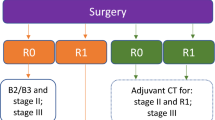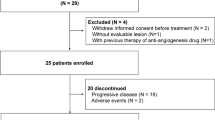Opinion statement
The management of thymic tumours is a paradigm of multidisciplinary collaboration. Chemotherapy may be administered part of curative-intent sequential strategy integrating subsequent surgery or radiotherapy, or as an exclusive treatment if local treatment is not achievable. Recurrences of thymic epithelial tumors should be managed according to the same strategy as newly diagnosed tumors. Given the limited activity of cytotoxic agents in the advanced, refractory setting, novel and innovative agents are needed. The better understanding of thymic carcinogenesis may provide a rationale in this setting.
Targeted agents approved for other solid tumors that have shown activity in thymic tumors include mTOR, KIT inhibitors, as well as somatostatin analogues. Anti-angiogenic agent sunitinib may be considered a standard in advanced lines of treatment. Ongoing studies are assessing the opportunity of targeting emerging targets, including PI3K, CDK, and immune checkpoint PD-1/PD-L1.


Similar content being viewed by others
References and Recommended Reading
Papers of particular interest, published recently, have been highlighted as: • Of importance •• Of major importance
• WHO histological classification of tumours of the thymus. In: Travis WB, Brambilla A, Burke AP, Marx A, Nicholson A. World Health Organization classification of tumours of the lung, pleura, thymus and heart. Lyon: IARC Press; 2015. This is the standard histopathological classification for thymic tumors.
Marx A, Ströbel P, Badve SS, et al. ITMIG consensus statement on the use of the WHO histological classification of thymoma and thymic carcinoma: refined definitions, histological criteria, and reporting. J Thorac Oncol. 2014;9:596–611.
Girard N. Neuroendocrine tumors of the thymus: the oncologist point of view. J Thorac Dis 2017; in press.
Detterbeck F, Nicholson AG, Kondo K, et al. The Masaoka-Koga stage classification for thymic malignancies: clarification and definition of terms. J Thorac Oncol. 2011;6:S1710–6.
• Detterbeck FC, Stratton K, Giroux D, et al. Staging and prognostic factors committee; members of the advisory boards; participating institutions of the thymic domain. The IASLC/ITMIG Thymic Epithelial Tumors Staging Project: proposal for an evidence-based stage classification system for the forthcoming (8th) edition of the TNM classification of malignant tumors. J Thorac Oncol. 2014;9:S65–72. This is the standard staging system for thymic tumors
•• Girard N, Ruffini E, Marx A, Faivre-Finn C, Peters S. ESMO guidelines committee. Thymic epithelial tumours: ESMO clinical practice guidelines for diagnosis, treatment and follow-up. Ann Oncol. 2015;26(Suppl 5):v40–55. These are the only comprehensive guidelines for thymic tumors
Girard M, Lal R, Wakelee H, et al. Chemotherapy definitions and policies for thymic malignancies. J Thorac Oncol. 2011;6:S1749–55.
Girard N, Merveilleux du Vignaux C. Systemic treatment for thymic malignancies. Curr Opin Oncol. 2017;29:112–7.
• Rajan A, Girard N, Marx A. State of the art of genetic alterations in thymic epithelial tumors. J Thorac Oncol. 2014;9(9 Suppl 2):S131–6. This is a landmark review on the molecular features of thymic tumors
Girard N, Shen R, Guo T, et al. Comprehensive genomic analysis reveals clinically relevant molecular distinctions between thymic carcinomas and thymomas. Clin Cancer Res. 2009;15:6790–9.
Breinig M, Mayer P, Harjung A, et al. Heat shock protein 90-sheltered overexpression of insulin-like growth factor 1 receptor contributes to malignancy of thymic epithelial tumors. Clin Cancer Res. 2011;17:2237–49.
Gökmen-Polar Y, Sanders KL, Goswami CP, et al. Establishment and characterization of a novel cell line derived from human thymoma AB tumor. Lab Investig. 2012;92:1564–73.
Alberobello AT, Wang Y, Beerkens FJ, et al. PI3K as a potential therapeutic target in thymic epithelial tumors. J Thorac Oncol. 2016;11:1345–56.
Girard N. Chasing therapeutic targets in thymic malignancies: finding needles in the haystack to frame a comprehensive canvas? J Thorac Oncol. 2016;11:1197–200.
Petrini I, Meltzer PS, Zucali PA, et al. Copy number aberrations of BCL2 and CDKN2A/B identified by array-CGH in thymic epithelial tumors. Cell Death Dis. 2012;3:e351.
Petrini I, Meltzer PS, Kim IK, et al. A specific missense mutation in GTF2I occurs at high frequency in thymic epithelial tumors. Nat Genet. 2014;46:844–9.
Kossai M, Duchemann B, Boutros C, et al. Antitumor activity in advanced cancer patients with thymic malignancies enrolled in early clinical drug development programs (phase I trials) at Gustave Roussy. Lung Cancer. 2015;89:306–10.
Wheler J, Hong D, Swisher SG, et al. Thymoma patients treated in a phase I clinic at MD Anderson Cancer Center: responses to mTOR inhibitors and molecular analyses. Oncotarget. 2013;4:890–8.
Zucali PA, De Pas TM, Palmieri G, et al. Phase II study of everolimus in patients with thymoma and thymic carcinoma previously treated with cisplatin-based chemotherapy. J Clin Oncol. 2014;32:7527. (abstract)
Giaccone G, Rajan A, Ruijter R, Smit E, van Groeningen C, Hogendoorn PC. Imatinib mesylate in patients with WHO B3 thymomas and thymic carcinomas. J Thorac Oncol. 2009;4:1270–3.
Salter JT, Lewis D, Yiannoutsos C, Loehrer PJ, Risley L, Chiorean EG. Imatinib for the treatment of thymic carcinoma. J Clin Oncol. 2008;26:8116. (abstract)
Palmieri G, Montella L, Martignetti A, et al. Somatostatin analogs and prednisone in advanced refractory thymic tumors. Cancer. 2002;94:1414–20.
Loehrer PJ Sr, Wang W, Johnson DH, et al. Eastern Cooperative Oncology Group Phase II Trial. Octreotide alone or with prednisone in patients with advanced thymoma and thymic carcinoma: an Eastern Cooperative Oncology Group Phase II Trial. J Clin Oncol. 2004;22:293–9.
Ottaviano M, Damiano V, Nappi L, et al. Effectiveness of somatostatin analogs plus prednisone in aggressive histotype and advanced stage of thymic epithelial tumors. J Clin Oncol 2015; 7532 (abstract).
Besse B, Garassino MB, Rajan A, et al. A phase II study of milciclib (PHA-848125AC) in patients (pts) with thymic carcinoma (TC). J Clin Oncol. 2014;32:7526. (abstract)
Rajan A, Carter CA, Berman A, et al. Cixutumumab for patients with recurrent or refractory advanced thymic epithelial tumours: a multicentre, open-label, phase 2 trial. Lancet Oncol. 2014;15:191–200.
Smith TJ. Insulin-like growth factor-I regulation of immune function: a potential therapeutic target in autoimmune diseases? Pharmacol Rev. 2010;62:199–236.
Giaccone G, Rajan A, Berman A, et al. Phase II study of belinostat in patients with recurrent or refractory advanced thymic epithelial tumors. J Clin Oncol. 2011;29:2052–9.
Thomas A, Rajan A, Szabo E, et al. A phase I/II trial of belinostat in combination with cisplatin, doxorubicin, and cyclophosphamide in thymic epithelial tumors: a clinical and translational study. Clin Cancer Res. 2014;20:5392–402.
Cimpean AM, Raica M, Encica S, Cornea R, Bocan V. Immunohistochemical expression of vascular endothelial growth factor A (VEGF), and its receptors (VEGFR1, 2) in normal and pathologic conditions of the human thymus. Ann Anat. 2008;190:238–45.
Marino M, Piantelli M. Immunohistochemistry of thymic epithelial tumors as a tool in translational research. J Thorac Surg Clin. 2011;21:33–46.
Berardi R, Brunelli A, Pagliaretta S, et al. Impact of VEGF, VEGFR, PDGFR, HIF and ERCC1 gene polymorphisms on thymic malignancies outcome after thymectomy. Oncotarget. 2015;6:19305–15.
•• Thomas A, Rajan A, Berman A, et al. Sunitinib in patients with chemotherapy-refractory thymoma and thymic carcinoma: an open-label phase 2 trial. Lancet Oncol. 2015;16:177–86. This is a landmark trial for antiangiogenics as standard treatment of refractory thymic tumors
Remon J, Girard N, Mazieres J, et al. Sunitinib in patients with advanced thymic malignancies: cohort from the French RYTHMIC network. Lung Cancer. 2016;97:99–104.
Besse B, Girard N, Gazzah A, Hierro C, Tabernero J, Debraud F, et al. Clinical activity of lucitanib in advanced thymic epithelial tumors. J Thorac Oncol 2015; 10: MINI 25.07 (abstract).
Girard N. Thymic malignancies: twisting between autoimmunity and immunotherapy. Lung Cancer. 2017;110:68–70.
Nishimura H, Honjo T, Minato N. Facilitation of beta selection and modification of positive selection in the thymus of PD-1-deficient mice. J Exp Med. 2000;191:891–8.
Katsuya Y, Fujita Y, Horinouchi H, Ohe Y, Watanabe S, Tsuta K. Immunohistochemical status of PD-L1 in thymoma and thymic carcinoma. Lung Cancer. 2015;88:154–9.
Padda SK, Riess JW, Schwartz EJ, Tian L, Kohrt HE, Neal JW, et al. Diffuse high intensity PD-L1 staining in thymic epithelial tumors. J Thorac Oncol. 2015;10:500–8.
Naidoo J, Steele K, Sima CS, Yuan J, Robbins PB, Moreira AL, et al. Defining the immunological phenotype of thymic epithelial tumors. J Clin Oncol. 2015;33(suppl; abstr):7516.
Yokoyama S, Miyoshi H, Nishi T, Hashiguchi T, Mitsuoka M, Takamori S, et al. Clinicopathologic and prognostic implications of programmed death ligand 1 expression in thymoma. Ann Thorac Surg. 2016;101:1361–9.
Yokoyama S, Miyoshi H, Nakashima K, Shimono J, Hashiguchi T, Mitsuoka M, et al. Prognostic value of programmed death ligand 1 and programmed death 1 expression in thymic carcinoma. Clin Cancer Res. 2016;22:4727–34.
Weissferdt A, Fujimoto J, Kalhor N, Rodriguez J, Bassett R, Wistuba II, et al. Expression of PD-1 and PD-L1 in thymic epithelial neoplasms. Mod Pathol. 2017; doi:10.1038/modpathol.2017.6.
Marchevsky AM, Walts AE. PD-L1, PD-1, CD4, and CD8 expression in neoplastic and nonneoplastic thymus. Hum Pathol. 2017;60:16–23.
Yang Y, Ding L, Wang P. Dramatic response to anti-PD-1 therapy in a patient of squamous cell carcinoma of thymus with multiple lung metastases. J Thorac Dis. 2016;8:E535–7.
Zander T, Aebi S, Rast AC, Zander A, Winterhalder R, Brand C, et al. Dramatic response to anti-PD-1 therapy in a patient of squamous cell carcinoma of thymus with multiple lung metastases. J Thorac Oncol. 2016;11:e147–9.
•• Giaccone G, Thompson J, Crawford J, et al. A phase II study of pembrolizumab in patients with recurrent thymic carcinoma. J Clin Oncol. 2016; 34: suppl; 8517. Abstr. This is a landmark trial with immunootherapy for thymic carcinoma.
Rajan A, Heery CR, Mammen AL, Pittaluga S, Lepone ML, Donahue RN, et al. OA18.03: safety and clinical activity of avelumab (MSB0010718C; anti-PD-L1) in patients with advanced thymic epithelial tumors (TETs). J Thorac Oncol. 2017;12:S130.
Cho J, Ahn MJ, Yoo KH, et al. A phase II study of pembrolizumab for patients with previously treated advanced thymic epithelial tumor. J Clin Oncol. 2017;35:8521. (abstract)
Thomas A, Chen Y, Berman A, et al. Expression of mesothelin in thymic carcinoma and its potential therapeutic significance. Lung Cancer. 2016;101:104–10.
Lattanzio R, La Sorda R, Facciolo F, et al. Thymic epithelial tumors express vascular endothelial growth factors and their receptors as potential targets of antiangiogenic therapy: a tissue microarray-based multicenter study. Lung Cancer. 2014;85:191–6.
Author information
Authors and Affiliations
Corresponding author
Ethics declarations
Conflict of Interest
Claire Merveilleux du Vignaux declares that she has no conflict of interest.
Jean-Michel Maury declares that he has no conflict of interest.
Nicolas Girard has received research support and travel grants from Novartis, Bristol-Myers Squibb, MSD, and Pfizer.
Human and Animal Rights and Informed Consent
This article does not contain any studies with human or animal subjects performed by any of the authors.
Additional information
This article is part of the Topical Collection on Lung Cancer
Rights and permissions
About this article
Cite this article
Merveilleux du Vignaux, C., Maury, JM. & Girard, N. Novel Agents in the Treatment of Thymic Malignancies. Curr. Treat. Options in Oncol. 18, 52 (2017). https://doi.org/10.1007/s11864-017-0495-8
Published:
DOI: https://doi.org/10.1007/s11864-017-0495-8




